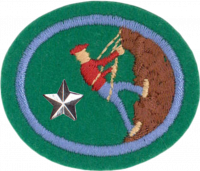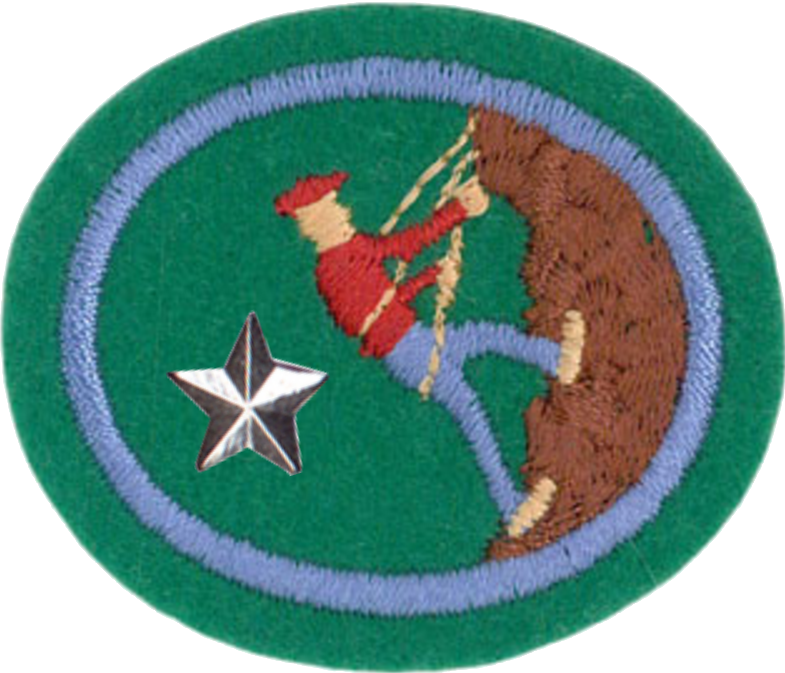Difference between revisions of "AY Honors/Rock Climbing - Advanced/Answer Key"
From Pathfinder Wiki
< AY Honors | Rock Climbing - AdvancedAY Honors/Rock Climbing - Advanced/Answer Key
Jomegat bot (talk | contribs) (Bot: Automated import of articles *** existing text overwritten ***) |
m |
||
| Line 4: | Line 4: | ||
<noinclude><translate><!--T:5--> | <noinclude><translate><!--T:5--> | ||
</noinclude> | </noinclude> | ||
| − | <!-- 1. Have the Rock Climbing | + | <!-- 1. Have the Rock Climbing honor. --> |
{{honor_prerequisite|category=Recreation|honor=Rock Climbing}} | {{honor_prerequisite|category=Recreation|honor=Rock Climbing}} | ||
| Line 13: | Line 13: | ||
<noinclude><translate><!--T:7--> | <noinclude><translate><!--T:7--> | ||
</noinclude> | </noinclude> | ||
| − | <!-- 2. Know and demonstrate the use of all special rock climbing equipment, such as bongs, RURP's, | + | <!-- 2. Know and demonstrate the use of all special rock climbing equipment, such as bongs, RURP's, knife blades, bolt equipment, hero loops, runners, etriers, and mechanical ascenders. --> |
<noinclude></translate></noinclude> | <noinclude></translate></noinclude> | ||
{{CloseReq}} <!-- 2 --> | {{CloseReq}} <!-- 2 --> | ||
| Line 19: | Line 19: | ||
<noinclude><translate><!--T:8--> | <noinclude><translate><!--T:8--> | ||
</noinclude> | </noinclude> | ||
| − | <!-- 3. Show how to use all free climbing moves, including: foot edging; finger-tip clings; lay backs; hand, arm, foot, and leg jamming; and stimming while climbing at 5.6(F6) difficulty on practice cliffs using an upper belay. | + | <!-- 3. Show how to use all free climbing moves, including: foot edging; finger-tip clings; lay backs; hand, arm, foot, and leg jamming; and stimming while climbing at 5.6(F6) difficulty on practice cliffs using an upper belay. --> |
<noinclude></translate></noinclude> | <noinclude></translate></noinclude> | ||
{{CloseReq}} <!-- 3 --> | {{CloseReq}} <!-- 3 --> | ||
| Line 25: | Line 25: | ||
<noinclude><translate><!--T:9--> | <noinclude><translate><!--T:9--> | ||
</noinclude> | </noinclude> | ||
| − | <!-- 4. Show how to belay properly and safely a lead climber. Show that you can catch a falling lead climber during a practice fall. | + | <!-- 4. Show how to belay properly and safely a lead climber. Show that you can catch a falling lead climber during a practice fall. --> |
<noinclude></translate></noinclude> | <noinclude></translate></noinclude> | ||
{{CloseReq}} <!-- 4 --> | {{CloseReq}} <!-- 4 --> | ||
| Line 31: | Line 31: | ||
<noinclude><translate><!--T:10--> | <noinclude><translate><!--T:10--> | ||
</noinclude> | </noinclude> | ||
| − | <!-- 5. Show how to lead and follow (by jumaring) a continuous Class 5 point 6 direct aid pitch of A2 difficulty of at least 20 feet (6.1 meters). | + | <!-- 5. Show how to lead and follow (by jumaring) a continuous Class 5 point 6 direct aid pitch of A2 difficulty of at least 20 feet (6.1 meters). --> |
<noinclude></translate></noinclude> | <noinclude></translate></noinclude> | ||
{{CloseReq}} <!-- 5 --> | {{CloseReq}} <!-- 5 --> | ||
| Line 37: | Line 37: | ||
<noinclude><translate><!--T:11--> | <noinclude><translate><!--T:11--> | ||
</noinclude> | </noinclude> | ||
| − | <!-- 6. Show how to raise and lower, using only normal climbing equipment, an injured climber safely and relatively comfortably. Construct a rope litter and demonstrate its proper use. | + | <!-- 6. Show how to raise and lower, using only normal climbing equipment, an injured climber safely and relatively comfortably. Construct a rope litter and demonstrate its proper use. --> |
<noinclude></translate></noinclude> | <noinclude></translate></noinclude> | ||
{{CloseReq}} <!-- 6 --> | {{CloseReq}} <!-- 6 --> | ||
| Line 43: | Line 43: | ||
<noinclude><translate><!--T:12--> | <noinclude><translate><!--T:12--> | ||
</noinclude> | </noinclude> | ||
| − | <!-- 7. Participate in at least two multi-pitch climbs of 5.5 (F5) difficulty or above, involving at least 120 feet (36.6 meters) of climbing each and leading at least two of the pitches. | + | <!-- 7. Participate in at least two multi-pitch climbs of 5.5 (F5) difficulty or above, involving at least 120 feet (36.6 meters) of climbing each and leading at least two of the pitches. --> |
<noinclude></translate></noinclude> | <noinclude></translate></noinclude> | ||
{{CloseReq}} <!-- 7 --> | {{CloseReq}} <!-- 7 --> | ||
{{ansreq|page={{#titleparts:{{PAGENAME}}|2|1}}|num=8}} | {{ansreq|page={{#titleparts:{{PAGENAME}}|2|1}}|num=8}} | ||
<noinclude><translate><!--T:13--> | <noinclude><translate><!--T:13--> | ||
| − | </ | + | </noinclue> |
| − | <!-- 8. Select a minimum of bivouac equipment, including food for a supper and break- fast, and spend one night bivouacked on a rock ledge at least 30 feet (9.1 meters) high and reached by moderate climbing, hauling equipment up by proper rope hauling methods. | + | <!-- 8. Select a minimum of bivouac equipment, including food for a supper and break- fast, and spend one night bivouacked on a rock ledge at least 30 feet (9.1 meters) high and reached by moderate climbing, hauling equipment up by proper rope hauling methods. --> |
<noinclude></translate></noinclude> | <noinclude></translate></noinclude> | ||
{{CloseReq}} <!-- 8 --> | {{CloseReq}} <!-- 8 --> | ||
| Line 55: | Line 55: | ||
<noinclude><translate><!--T:14--> | <noinclude><translate><!--T:14--> | ||
</noinclude> | </noinclude> | ||
| − | <!-- 9. Demonstrate basic map and compass use. Explain how the map can be useful to the rock climber and how to determine compass bearing from the map. | + | <!-- 9. Demonstrate basic map and compass use. Explain how the map can be useful to the rock climber and how to determine compass bearing from the map. --> |
<noinclude></translate></noinclude> | <noinclude></translate></noinclude> | ||
{{CloseReq}} <!-- 9 --> | {{CloseReq}} <!-- 9 --> | ||
Revision as of 19:59, 24 May 2021
Rock Climbing - Advanced
Skill Level
3
Year
1970
Version
20.12.2025
Approval authority
General Conference
1
Have the Rock Climbing honor.
For tips and instruction see Rock Climbing.
2
Know and demonstrate the use of all special rock climbing equipment, such as bongs, RURP's, knife blades, bolt equipment, hero loops, runners, etriers, and mechanical ascenders.
3
Show how to use all free climbing moves, including: foot edging; finger-tip clings; lay backs; hand, arm, foot, and leg jamming; and stimming while climbing at 5.6(F6) difficulty on practice cliffs using an upper belay.
4
Show how to belay properly and safely a lead climber. Show that you can catch a falling lead climber during a practice fall.
5
Show how to lead and follow (by jumaring) a continuous Class 5 point 6 direct aid pitch of A2 difficulty of at least 20 feet (6.1 meters).
6
Show how to raise and lower, using only normal climbing equipment, an injured climber safely and relatively comfortably. Construct a rope litter and demonstrate its proper use.
7
Participate in at least two multi-pitch climbs of 5.5 (F5) difficulty or above, involving at least 120 feet (36.6 meters) of climbing each and leading at least two of the pitches.
8
Select a minimum of bivouac equipment, including food for a supper and break- fast, and spend one night bivouacked on a rock ledge at least 30 feet (9.1 meters) high and reached by moderate climbing, hauling equipment up by proper rope hauling methods.
</noinclue>
9
Demonstrate basic map and compass use. Explain how the map can be useful to the rock climber and how to determine compass bearing from the map.


